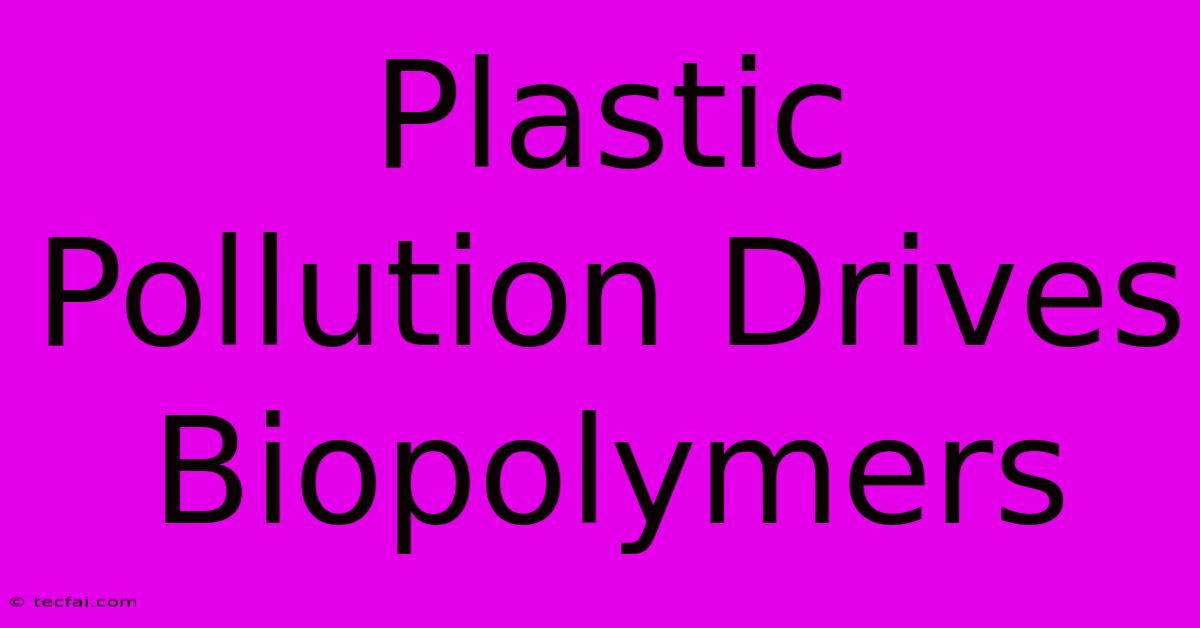Plastic Pollution Drives Biopolymers

Discover more detailed and exciting information on our website. Click the link below to start your adventure: Visit Best Website tecfai.com. Don't miss out!
Table of Contents
Plastic Pollution Drives Biopolymers: A Sustainable Solution?
The world is drowning in plastic. Millions of tons of plastic waste pollute our oceans, landfills, and even our most remote ecosystems. This pervasive pollution isn't just an eyesore; it's a critical environmental and health crisis. The urgency of this problem is fueling a rapid surge in the development and adoption of biopolymers – a promising alternative to traditional, petroleum-based plastics. But are biopolymers truly a sustainable solution, and can they effectively combat plastic pollution? Let's delve into the details.
What are Biopolymers?
Biopolymers are polymers derived from renewable biomass sources, such as plants, microorganisms, and agricultural waste. Unlike conventional plastics, which are synthesized from fossil fuels, biopolymers offer a more environmentally friendly alternative. They are biodegradable, meaning they can be broken down by microorganisms into natural substances, unlike many plastics that persist in the environment for centuries.
Several types of biopolymers exist, each with its unique properties and applications:
-
Polylactic acid (PLA): Commonly used in food packaging, 3D printing filaments, and disposable tableware. PLA is compostable under industrial conditions but not in typical home composting environments.
-
Polyhydroxyalkanoates (PHAs): A family of polymers with diverse properties, suitable for various applications, from packaging to medical implants. PHAs generally exhibit superior biodegradability compared to PLA.
-
Starch-based polymers: These are often blended with other polymers to improve their properties and are frequently used in disposable bags and packaging films. Their biodegradability is influenced by the specific blend and environmental conditions.
How Biopolymers Address Plastic Pollution
The primary advantage of biopolymers in tackling plastic pollution lies in their biodegradability. This feature significantly reduces the environmental burden associated with persistent plastic waste. By replacing conventional plastics with biopolymers, we can potentially:
-
Reduce landfill waste: Biodegradable polymers decompose naturally, reducing the volume of plastic accumulating in landfills.
-
Minimize ocean pollution: Biopolymers pose a lower risk of persistent marine pollution, safeguarding marine ecosystems and wildlife.
-
Lower carbon footprint: Depending on the production process, biopolymers can have a lower carbon footprint than conventional plastics, contributing to climate change mitigation.
-
Promote circular economy: Biopolymers can be incorporated into closed-loop systems, allowing for their efficient recovery and reuse or composting.
Challenges and Considerations
Despite their promise, biopolymers aren't a silver bullet. Several challenges hinder their widespread adoption:
-
Cost: Biopolymers are currently more expensive to produce than traditional plastics.
-
Scalability: Scaling up production to meet global demand remains a significant hurdle.
-
Performance limitations: Some biopolymers might not possess the same strength, durability, or barrier properties as conventional plastics, limiting their applicability.
-
Composting infrastructure: The effective biodegradation of some biopolymers requires specific composting facilities, which are not readily available everywhere.
The Future of Biopolymers in Combating Plastic Pollution
While challenges remain, the future of biopolymers looks bright. Continued research and development are addressing cost and performance limitations. As awareness of plastic pollution grows, consumer demand for sustainable alternatives is increasing, driving innovation and investment in the biopolymer industry. Moreover, advancements in biotechnology and industrial processes are paving the way for more efficient and cost-effective biopolymer production.
Conclusion:
Biopolymers offer a promising pathway towards mitigating the devastating effects of plastic pollution. While not a perfect solution, they represent a critical step towards a more sustainable future. Through continued innovation, improved infrastructure, and responsible consumption patterns, biopolymers have the potential to play a pivotal role in creating a cleaner and healthier planet. The urgent need to address plastic pollution is driving significant advancements in this field, promising a future where bio-based alternatives replace conventional plastics, significantly reducing our environmental burden.

Thank you for visiting our website wich cover about Plastic Pollution Drives Biopolymers. We hope the information provided has been useful to you. Feel free to contact us if you have any questions or need further assistance. See you next time and dont miss to bookmark.
Featured Posts
-
Tulong Ng Seahorse Sa Biyolohikal Na Paghahanap
Nov 19, 2024
-
Muling Natuklasan Species Ng Worm Sa Litrato
Nov 19, 2024
-
Extra Wolfe Tones Show Announced
Nov 19, 2024
-
2024 2031 Biodegradable Packaging Market Trends
Nov 19, 2024
-
Horror House Neighbors Trash
Nov 19, 2024
